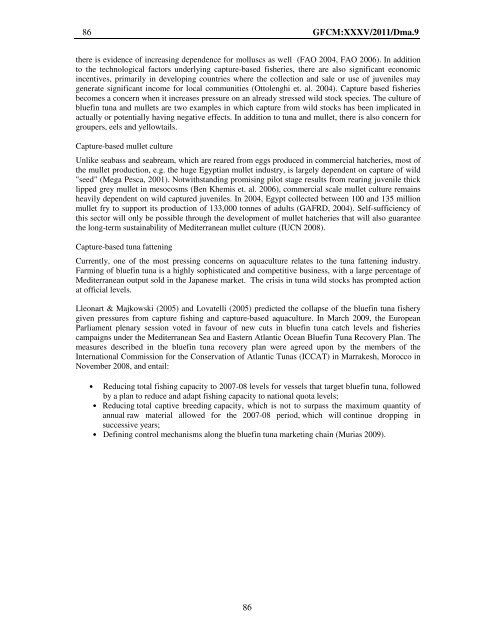Site selection and carrying capacity in Mediterranean ... - FAO Sipam
Site selection and carrying capacity in Mediterranean ... - FAO Sipam
Site selection and carrying capacity in Mediterranean ... - FAO Sipam
Create successful ePaper yourself
Turn your PDF publications into a flip-book with our unique Google optimized e-Paper software.
86 GFCM:XXXV/2011/Dma.9<br />
there is evidence of <strong>in</strong>creas<strong>in</strong>g dependence for molluscs as well (<strong>FAO</strong> 2004, <strong>FAO</strong> 2006). In addition<br />
to the technological factors underly<strong>in</strong>g capture-based fisheries, there are also significant economic<br />
<strong>in</strong>centives, primarily <strong>in</strong> develop<strong>in</strong>g countries where the collection <strong>and</strong> sale or use of juveniles may<br />
generate significant <strong>in</strong>come for local communities (Ottolenghi et. al. 2004). Capture based fisheries<br />
becomes a concern when it <strong>in</strong>creases pressure on an already stressed wild stock species. The culture of<br />
bluef<strong>in</strong> tuna <strong>and</strong> mullets are two examples <strong>in</strong> which capture from wild stocks has been implicated <strong>in</strong><br />
actually or potentially hav<strong>in</strong>g negative effects. In addition to tuna <strong>and</strong> mullet, there is also concern for<br />
groupers, eels <strong>and</strong> yellowtails.<br />
Capture-based mullet culture<br />
Unlike seabass <strong>and</strong> seabream, which are reared from eggs produced <strong>in</strong> commercial hatcheries, most of<br />
the mullet production, e.g. the huge Egyptian mullet <strong>in</strong>dustry, is largely dependent on capture of wild<br />
"seed" (Mega Pesca, 2001). Notwithst<strong>and</strong><strong>in</strong>g promis<strong>in</strong>g pilot stage results from rear<strong>in</strong>g juvenile thick<br />
lipped grey mullet <strong>in</strong> mesocosms (Ben Khemis et. al. 2006), commercial scale mullet culture rema<strong>in</strong>s<br />
heavily dependent on wild captured juveniles. In 2004, Egypt collected between 100 <strong>and</strong> 135 million<br />
mullet fry to support its production of 133,000 tonnes of adults (GAFRD, 2004). Self-sufficiency of<br />
this sector will only be possible through the development of mullet hatcheries that will also guarantee<br />
the long-term susta<strong>in</strong>ability of <strong>Mediterranean</strong> mullet culture (IUCN 2008).<br />
Capture-based tuna fatten<strong>in</strong>g<br />
Currently, one of the most press<strong>in</strong>g concerns on aquaculture relates to the tuna fatten<strong>in</strong>g <strong>in</strong>dustry.<br />
Farm<strong>in</strong>g of bluef<strong>in</strong> tuna is a highly sophisticated <strong>and</strong> competitive bus<strong>in</strong>ess, with a large percentage of<br />
<strong>Mediterranean</strong> output sold <strong>in</strong> the Japanese market. The crisis <strong>in</strong> tuna wild stocks has prompted action<br />
at official levels.<br />
Lleonart & Majkowski (2005) <strong>and</strong> Lovatelli (2005) predicted the collapse of the bluef<strong>in</strong> tuna fishery<br />
given pressures from capture fish<strong>in</strong>g <strong>and</strong> capture-based aquaculture. In March 2009, the European<br />
Parliament plenary session voted <strong>in</strong> favour of new cuts <strong>in</strong> bluef<strong>in</strong> tuna catch levels <strong>and</strong> fisheries<br />
campaigns under the <strong>Mediterranean</strong> Sea <strong>and</strong> Eastern Atlantic Ocean Bluef<strong>in</strong> Tuna Recovery Plan. The<br />
measures described <strong>in</strong> the bluef<strong>in</strong> tuna recovery plan were agreed upon by the members of the<br />
International Commission for the Conservation of Atlantic Tunas (ICCAT) <strong>in</strong> Marrakesh, Morocco <strong>in</strong><br />
November 2008, <strong>and</strong> entail:<br />
• Reduc<strong>in</strong>g total fish<strong>in</strong>g <strong>capacity</strong> to 2007-08 levels for vessels that target bluef<strong>in</strong> tuna, followed<br />
by a plan to reduce <strong>and</strong> adapt fish<strong>in</strong>g <strong>capacity</strong> to national quota levels;<br />
• Reduc<strong>in</strong>g total captive breed<strong>in</strong>g <strong>capacity</strong>, which is not to surpass the maximum quantity of<br />
annual raw material allowed for the 2007-08 period, which will cont<strong>in</strong>ue dropp<strong>in</strong>g <strong>in</strong><br />
successive years;<br />
• Def<strong>in</strong><strong>in</strong>g control mechanisms along the bluef<strong>in</strong> tuna market<strong>in</strong>g cha<strong>in</strong> (Murias 2009).<br />
86
















